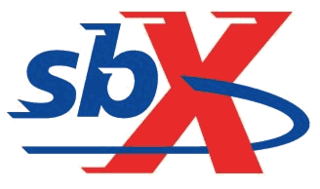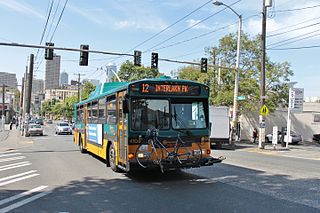
MetroLink is the light rail transit system in the Greater St. Louis area of Missouri and the Metro East area of Illinois. The system consists of two lines connecting Lambert-St. Louis International Airport and Shrewsbury, Missouri with Scott Air Force Base near Shiloh, Illinois through downtown St. Louis. The system features 38 stations and carries an average of 53,123 people each weekday. As of the first quarter of 2015, it is second only to Minneapolis Metro Transit's Blue and Green lines in the Midwestern United States in terms of ridership, and is the 11th-largest light rail system in the country.

The Santa Clara Valley Transportation Authority (VTA) is a special district responsible for public transit services, congestion management, specific highway improvement projects, and countywide transportation planning for Santa Clara County, California. It is one of the governing parties for the Caltrain commuter rail line that serves the county.

The Greater Cleveland Regional Transit Authority is the public transit agency for Cleveland, Ohio, United States and the surrounding suburbs of Cuyahoga County. RTA is the largest transit agency in Ohio, providing over 44 million trips to residents and visitors of the Cleveland area in 2010. RTA owns and operates the RTA Rapid Transit rail system, which consists of one heavy rail line and two interurban light rail lines. The bulk of RTA's service consists of buses, including regular routes, express or flyer buses, loop and paratransit buses. In December 2004, RTA adopted a revised master plan, Transit 2025, in which several rail extensions, bus line improvements and transit oriented developments are discussed.

Metro Transit is an enterprise of Bi-State Development, an interstate compact formed by Missouri and Illinois in 1949. Its operating budget in 2016 was $280 million, which is funded by sales taxes from the City of St. Louis and St. Louis County, the St. Clair County Illinois Transit District, federal and state grants and subsidies, and through fare paying passengers.

San Joaquin Regional Transit District is a transit district that provides bus service to the city of Stockton, California and the surrounding communities of Lodi, Ripon, Thornton, French Camp, Lathrop, Manteca, and Tracy.
San Joaquin RTD operates 35 fixed routes to the Stockton metropolitan area, including 4 Metro Express routes, RTD’s Bus Rapid Transit service. As of April 29, 2018, RTD has a contract with National Express Transit, whom operates RTD's county services. County services includes six Interregional Commuter routes that serve Sacramento, the East Bay, and the Silicon Valley with subscription service available for commuters. In addition, National Express also operates both Metro and County Hopper Routes, along with the Intercity route 23.

The Metro Area Express (MAX) is express bus service with bus rapid transit characteristics run by the Kansas City Area Transportation Authority in Kansas City, Missouri, United States. The first service opened on Main Street on July 2005. The second service on Troost Avenue opened on January 1, 2011. MAX was an instant success, with ridership on the first MAX line increasing more than 50%. The Federal Transit Administration holds it up as a model BRT line. MAX has little mileage of dedicated lanes, and lacks off-board fare collection and platform boarding.
The Rush Line Corridor is a transport corridor and proposed commuter rail service that would run from Union Depot in downtown Saint Paul to Hinckley, Minnesota. It roughly follows the path of U.S. Route 61 and Interstate 35. Along with the Red Rock Corridor in the southeast and the Southwest Corridor in the southwest metro, it is considered a "Tier Two" commuter rail project with scheduled implementation after 2020. Efforts to improve the corridor are coordinated by the Rush Line Corridor Task Force, formed in 1999 and composed of 22 elected officials from counties and municipalities along the corridor.
The METRO Red Line, previously known as the Cedar Avenue Bus Rapid Transitway, is a bus line between the Twin Cities suburbs of Bloomington, Minnesota and Apple Valley, Minnesota. The Red Line was built with bus rapid transit elements including dedicated bus lanes along the sides of Minnesota State Highway 77/County Road 23, as well as distinct stations, although it cannot be classified as Bus Rapid Transit in accordance with the BRT Standard. The line is planned to be extended to the suburb of Lakeville, Minnesota, eventually running from Mall of America in Bloomington, the southern terminus of the Blue Line light-rail service, to 215th Street in Lakeville.
There are several passenger rail projects being discussed in Minnesota. There is one existing commuter rail service in the state, the Northstar Line, and one existing long-distance intercity rail service, the Empire Builder. Future projects include a mixture of short-distance commuter rail and medium-distance regional rail lines which would run from the Twin Cities outward to neighboring states and perhaps Canada.
The METRO Orange Line, also known as the I-35W Bus Rapid Transitway, is a proposed bus rapid transit line extending from downtown Minneapolis, Minnesota to Lakeville, Minnesota along Interstate 35W.
The Robert Street Corridor is a proposed light rail or bus rapid transit corridor, from downtown Saint Paul, Minnesota, to its southern suburbs. Robert Street is named after Captain Louis Robert, an early resident of Saint Paul. The corridor's population is expected to grow 45% and 27% more jobs are expected to come to the area from 2000 to 2030. In the 2006 state bonding bill, $500,000 was set aside to study the feasibility of adding mass transit. The corridor will most likely be bus rapid transit due to low ridership levels. In the Metropolitan Council's 2030 Transportation Policy Plan Robert Street is one of nine arterial streets that are recommended for bus rapid transit. Six of the nine corridors would be built by 2020 and the remaining three would be built by 2030.
MetroRapid is an express bus system in Tampa, Florida. Operated by Hillsborough Area Regional Transit, it incorporates some bus rapid transit features. Currently, there is only one line in operation, the North-South line, with an East-West line in the planning phase. Subsequent lines could open depending on the success of the two initial lines.
The St. Louis Commuter Rail is a series of proposed commuter rail lines being developed by Metro's Moving Transit Forward Plan.

Bus rapid transit in New Jersey comprises limited-stop bus service, exclusive bus lanes (XBL) and bus bypass shoulders (BBS). Under the banner Next Generation Bus New Jersey Transit (NJT), the New Jersey Department of Transportation (NJDOT), and the metropolitan planning organizations of New Jersey (MPO) which recommend and authorize transportation projects are undertaking the creation of several additional bus rapid transit systems (BRT) in the state. In 2011, NJT announced that it would equip its entire bus fleet with devices for real-time locating, thus creating the basis for "next bus" scheduling information at bus shelters. The introduction and expanded use of bus rapid transit in Garden State is part of worldwide phenomenon to bring mass transit to heavily trafficked corridors in both high and medium density areas as a cost-saving, and sometimes more flexible, alternative to rail transportation, thus reducing automobile dependency and traffic congestion.

Metro is a high-capacity transport network serving the Minneapolis-St. Paul metropolitan area. As of 2016, the system consists of two light rail lines, along with the Red Line, a bus rapid transit extension of the Blue Line operated by the Minnesota Valley Transit Authority. The three lines connect Downtown Minneapolis and St. Paul with Bloomington and Minneapolis-St. Paul International Airport, with several extensions in the planning stages.

The A-Line is a planned bus rapid transit line running along James Street in downtown and Upper James Street on the escarpment in Hamilton, Ontario. It is part of Hamilton's proposed BLAST network, involving four other rapid transit corridors. It is identified by Metrolinx in its regional transportation plan The Big Move as a project to be completed by 2023.

sbX is a bus rapid transit (BRT) service in San Bernardino and Loma Linda, California, United States. It is operated by Omnitrans, a public transportation agency in southwestern San Bernardino County. The route is internally named by Omnitrans as the Green Line.

The G Line is a future RapidRide bus service in Seattle, Washington, operated by King County Metro on Madison Street between Downtown Seattle and Madison Valley. The line is expected to enter service in 2021.














